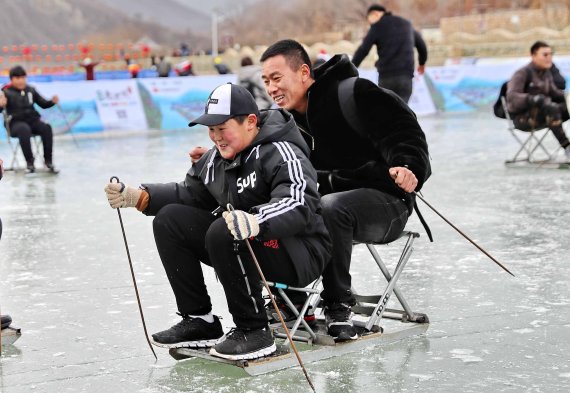
China is crazy about soccer! Soccer pitches are being built on virtually every corner of China's cities, with artificial turf and floodlights, and soccer is played day and night. Of course, China's passion for soccer has not gone unnoticed by top international clubs, and teams from the English Premier League, the German Bundesliga and Spain's Primera Division are particularly active in the Middle Kingdom.
The absolute industry leader is Manchester United. The traditional English club is the undisputed digital number one with 107 million followers. To put the figure in perspective: Around 66 million people currently live in Great Britain. (Source: Red Card 2018, China Digital Football Awards)
If you play sports, you naturally have to dress accordingly - and here the US sporting goods manufacturer Nike has continued to expand its supremacy in China in 2018. According to figures for the second quarter, Nike recorded $1.38 billion in sales, a 20 percent increase on the previous quarter after adjusting for currency effects. Overall, Nike has increased revenue by double digits for 17 consecutive quarters.
In its home market of North America, the sales increase was just six percent. Competitor Adidas sold only slightly more merchandise in the Asia-Pacific region as a whole during the same period, at $1.7 billion. (Source: Sales Reports Nike and Adidas 2nd Quarter 2018)
The most successful sports brands in China in pictures
Consumption is very important in China, and the brand awareness of the Chinese has long since reached a Western level. Accordingly, there is a very special day in China to pay homage to consumption. The Singles Day is Christmas, Easter and Valentine's Day all at once for wholesalers and retailers. On 11.11, China goes completely nuts and shops as if the world would end the next day. Online retailer Alibaba turned over $30.8 billion in 24 hours in 2018, up 27 percent from the previous year. 180,000 brands from China and the rest of the world were in the range, including, for example, market leaders such as Apple, Nike, Adidas and GAP.
To store from the comfort of their couch on Singles Day, the Chinese use their WeChat app. The smartphone application is a communication platform, social network, department store, bank, and so much more. In China alone, over 900 million users use the app every day, spending an average of almost 70 minutes on WeChat services. Globally, there are already over one billion users, putting WeChat not that far behind WhatsApp, which stood at 1.5 billion users in January 2018. (Source: Statista)
In general, the Chinese have a special relationship with their smartphones. The networks are well developed, coverage with fast Internet is excellent, especially in the metropolitan areas, and with apps like WeChat or Weibo (China's answer to Twitter), bulky desktop computers are becoming almost obsolete. At the beginning of 2018, 802 million Chinese had access to the Internet, about 58 percent of the population. That's still expandable, of course, especially in the western provinces of the giant empire, but one figure is particularly noteworthy. When Chinese use the Internet, they do so via their smartphones, as 788 of the 802 million Internet users (98 percent) use their smartphones for this purpose.
In addition to their love of smartphones, China's citizens are also increasingly discovering active sports for themselves. Running, skiing, snowboarding, everything is being tried out - and the government is supporting its citizens wherever possible. By 2020, one billion Chinese should be doing sports, according to the government's national fitness plan. Running sports in particular seem to appeal to the Chinese. In 2017, 328 marathons involving 2.8 million runners were held in China alone, according to the Chinese Athletic Association, compared with a meager 22 races six years earlier. Overall, the number of running events rose to 1102 races.
With the 2022 Winter Olympics in Beijing, winter sports are naturally booming in China. New ski resorts are opening even in the most remote parts of the country and even where there is no snow - such as in Shanghai - winter sports are being made possible. The latest mega-project is called Wintastar Shanghai, and when it opens it will be the largest indoor ski hall in the world. It will offer 90,000 square meters of slopes, with the longest run meeting Olympic training standards and measuring three kilometers in length. In addition, the complex, designed by star designer Massimo Mercurio, will feature restaurants, stores, a spa and an ice skating rink.
Welchen Sport Chinesen lieben - und welchen sie machen
3.2 million visitors are expected annually to Wintastar Shanghai, compared to the current figures for active winter sports enthusiasts in the White Book 2017, this is a considerable forecast. After all, according to the annual study conducted by China's winter sports experts and ISPO Beijing Panel Speaker Wu Bin, the number of winter sports enthusiasts in China amounted to 12.1 million Chinese, with the 703 resorts recording 17.5 million visits. Even though this means only about one percent of China's population actively participates in winter sports, the 17.5 million visits to Chinese resorts nearly matched Switzerland (23 million) during the same period. By the time of the 2022 Winter Olympics, the number is expected to increase again significantly with the help of government programs, with 300 million winter sports visitors planned according to the party plan.
With the 2022 Olympic Winter Games in Beijing, winter sports in China naturally boom, too. New ski resorts are opening up even in the remotest parts of the country - and even in placed with no snow - like Shanghai - winter sports are being made possible. The latest mega-project is called Wintastar Shanghai and will be the largest indoor ski slope in the world at its opening. 90,000 square meters of pistes are to be offered, whereby the longest slope is to meet Olympic training standards and will have three kilometers length. In addition, the complex planned by star designer Massimo Mercurio will include restaurants, shops, a spa, and an ice rink.
3.2 million visitors are expected annually at Wintastar Shanghai, which is a remarkable forecast compared to the current figures of active winter sports enthusiasts in the White Book 2017. According to the annual study by China's winter sports experts and ISPO Beijing Panel Speaker Wu Bin, the number of winter athletes in China amounted to 12.1 million Chinese, with the 703 resorts recording 17.5 million visits. Even though only about one percent of the Chinese population actively practizes winter sports, the 17.5 million visits to Chinese resorts almost reached the level of Switzerland (23 million) in the same period. Until the 2022 Winter Olympics, the number is to increase significantly with the help of government programs, with 300 million winter athletes planned according to the party plan.

 Sports BusinessSki Mountaineering Goes Olympic: What Milano-Cortina 2026 Means
Sports BusinessSki Mountaineering Goes Olympic: What Milano-Cortina 2026 Means
- ISPO awards
- Mountain sports
- Bike
- Design
- Retail
- Fitness
- Health
- ISPO Job Market
- ISPO Munich
- ISPO Shanghai
- Running
- Brands
- Sustainability
- Olympia
- OutDoor
- Promotion
- Sports Business
- ISPO Textrends
- Triathlon
- Water sports
- Winter sports
- eSports
- SportsTech
- OutDoor by ISPO
- Heroes
- Transformation
- Sport Fashion
- Urban Culture
- Challenges of a CEO
- Trade fairs
- Sports
- Find the Balance
- Product reviews
- Newsletter Exclusive Area
- Magazine






































